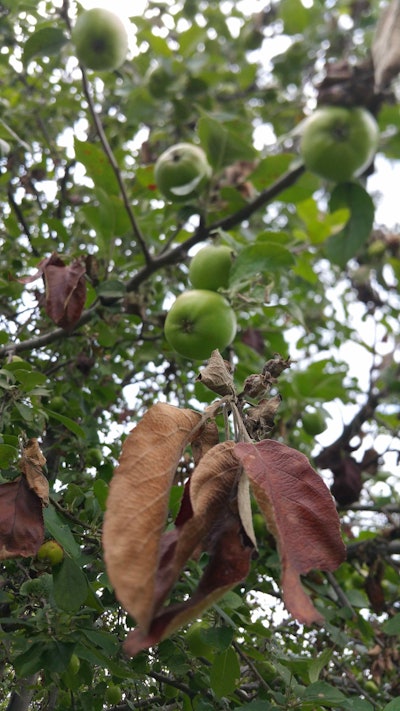Last year, researchers at the University of Georgia Extension Service noted that fire blight appeared on a growing number of pear trees, but this year there may be hope yet for infected trees.
 Photo:karen_hine/Flickr
Photo:karen_hine/FlickrScientists say that fire blight is the oldest, most serious and most perplexing bacterial fruit tree disease. It is caused by the bacteria Erwinia amylovora, and it is extremely common.
It can affect any of the plants in the Rosaceae family. Apple, crabapple, pyracantha, quince, hawthorn, loquat and cotoneaster are all particularly vulnerable. Fire blight appears as a reddish, watery ooze coming out of a branch or trunk cankers as soon as the infected plant begins active growth.
Infected flowers and stems turn brown or black and wither, and the bacteria spreads through rain and pollinators. Copper products can be sprayed to reduce the bacteria’s ability to survive and reproduce.
A recent discovery in Connecticut could now offer growers a new line of defense against the disease. Scientists created the first antibiotic for controlling fire blight in 1950 called Streptomycin. Unfortunately, after about 20 years the bacteria started developing a resistance to the antibiotic. Since then, scientists have continued searching for new ways to control fire blight.
“I feel it’s my responsibility to help the growers to come up with some ways to combat this disease,” Quan Zeng, the assistant plant pathologist and bacteriologist at the Connecticut Agricultural Experiment Station, told WSHU Public Radio Group. “As a plant pathologist, I often start my research from a disease problem that really has a big economic value.”
Estimated annual losses of apple trees to fire blight are over 100 million, and these trees contribute about 14 billion dollars to the national economy each year.
Zeng serves as one of the seven authors on a recent study that proved there is new technology that can help fight fire blight. The result of this research was the Antisense Peptide Nucleic Acid- Cell Penetrating Peptide. This uses a special strand of Peptide Nucleic Acid (PNA), which looks just like DNA.
This PNA breaks into the cells of the bad bacteria and scans the bacteria’s DNA to find the essential gene that keeps the bacteria alive. This antibiotic can be made to kill only the bad bacteria, unlike others which kill both good and bad.
“The short answer is, I borrowed some old ideas from animal pathogens, combined with some of the uniqueness in plant agriculture and came out with these research findings,” Zeng told WSHU Public Radio Group. “So, they will come and bind to those essential genes, and once the essential genes are bound by these molecules, those genes will be destroyed.”
According to Zeng, this selectivity also means fire blight is less likely to develop a resistance to the bacteria, and even if it eventually does, it will be an easy fix.
“The beauty of this technique is you can design the sequence, you can write a code,” Zeng told WSHU Public Radio Group. “And if the bacteria change their sequence as a result of resistance, you can rewrite the code so you overcome this resistance.”
Zeng says that while it may take a while to get this technology into the hands of growers, since the technology has been proven effective, other plant pathologists will be able to use it.
“To me it opens a new, a whole area in plant disease management,” Zeng told WSHU Public Radio Group. “I can see that it also has a great potential to be used in controlling many devastating plant diseases.”











